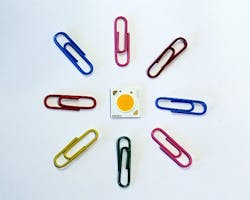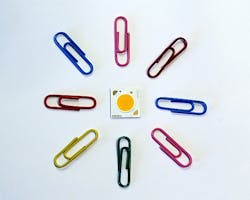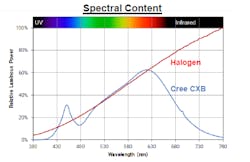New 6- and 9-mm-LES chip-on-board LEDs increase lumen density and promise to dramatically shrink form factor in high-output directional SSL products.
Cree has announced the second-generation of its CXA High-Density chip-on-board (COB) LED family, with the first two products offering a 6- or 9-mm light emitting surface (LES). Moreover, Cree has publicly touted white-point options below the black-body locus for the first time, although the company said it quietly added the option to its COB portfolio last year. Essentially, the CXA2 family offers solid-state lighting (SSL) product developers in the range of a 40% improvement in performance over Cree's CXA High Density LEDs.
Interested in more articles & announcements on COB LEDs?
Paul Scheidt, leader of LED product marketing at Cree, said the new LEDs deliver the "most lumens in the smallest amount of space in the industry." Making a rough analogy, Scheidt said one of the 9-mm COB LEDs can deliver the equivalent light output of seven 60W light bulbs.
Cree first announced the High Density addition to the standard CXA product line back in September 2013 with a 9-mm product. In early 2014, the company expanded the High Density offering to 6-, 12-, and 19-mm LEDs and introduced the concept of what it continues to call optical control factor (OCF). High OCF results from having a relatively small LES that ensures higher center beam candle power (CBCP) for directional products.
6- and 9-mm products lead
The first two CXA2 series COB LEDs are the 6-mm CXB1310 and 9-mm CXB1520. Both give product developers numerous options including substituting one of the new LEDs into a product and achieving greater output, or shrinking the footprint of products while maintaining the same output. The original CXA1310 6-mm LED topped out at 18W and 1450 lm, while the new CXB1310 can operate at 24W and deliver 2717 lm. At the equivalent 1450-lm mark, the new LED operates from 39% less power.
The new CXB1520 can deliver 5273 lm at 48W relative to the CXA1520, maxing out at 2622 lm and 31W. At the 2622-lm mark, the new LED operates from 42% less power. Meanwhile, the maximum lumen output is almost double.
"The CXB1520 High Density LED allows us to deliver downlights that provide up to 2700 lm with just 28W in a very small 4-in. trim platform," said Justin Weaver, vice president of engineering at LF Illumination. "What was previously only possible in much larger platforms with much higher wattage requirements is now made possible in our VF Series Specification Grade Luminaire Downlight product line using Cree’s CXB1520 High Density LEDs. The very high efficacy of the CXB1520 High Density LED also allows us to move many of our products that at one time were only possible with active cooling solutions to passive solutions, simplifying our design and lowering our system costs significantly."
Cree made some more detailed comparisons as to what is possible with the new LEDs. The company compared its standard-density, 12-mm CXB1816 LED with the CXB1310 in a 10° beam directional application. A typical design would have a 111-mm-diameter reflector with the larger LED and a 50-mm reflector with the new device.
The company also revisited its Mini Punch track-head reference design that won a Lighting for Tomorrow award in 2014. The original used the CXA1310 LED to deliver CBCP of 2093 cd at 3000K CCT and 82 CRI. The CXB1310 takes that CBCP to 2885 cd. That Mini Punch design measures 30 mm in diameter. Scheidt said the new version "easily outperforms a 70W halogen PAR38" that measures 120 mm in diameter. Cree also has shown a 41W prototype PAR20 design using the CXB1520 that outperforms a 70W ceramic metal halide (CMH) PAR38 lamp.
Below the black body
The new COB LEDs will come in a wide range of options from 2700K to 5000K in CCT, and 70, 80, or 90 CRI. Three-step MacAdam ellipse bins will be standard although Cree will offer two- and five-step options, all characterized at 85°C. And for the first time, Cree has publicly announced the aforementioned below the black-body bins as an option.
Many believe that some people prefer whites that are located below the black body. Moreover, CMH lamps that many developers want to mimic operate below the black body. Lumileds was perhaps first to offer such performance with its CrispWhite LEDs in 2014. Subsequently, Bridgelux, Samsung, Luminus Devices, and others have added such bins.
Scheidt said Cree saw no reason to publicly tout the below-the-black-body option when it rolled out the CXA standard-density COB products last year, and even now is slow-playing the news. Scheidt said it was relatively simple to put more blue energy into the LED, and noted, "When you want to talk about whiteness, follow the blue."
For now, Cree is offering two additional bins beyond the standard ANSI bins. The 30Q bin at 3000K is intended to match the performance of CMH lamps. And that bin is within the ANSI quadrangles, meaning that lamps based on the COB LEDs will remain within Energy Star and DesignLights Consortium (DLC) guidelines. Cree will also offer a 30U bin even further from the locus for more of what the company calls a pink/vivid effect, but that bin falls outside the ANSI space. For more about white-space definition and bins, see our recent feature article on the topic.
Of course, the Cree COB LEDs can also match the performance of lamps along the black-body locus. Halogen remains a popular target. The nearby figure shows how closely the Cree 30G bin matches the spectral power distribution (SPD) of a typical halogen lamp while also matching the color rendering performance. Note that the LED energy rolls off quickly approaching the infrared region, and that is a desired performance trait because the halogen lamp is wasting energy in the region outside the human sensitivity range.







